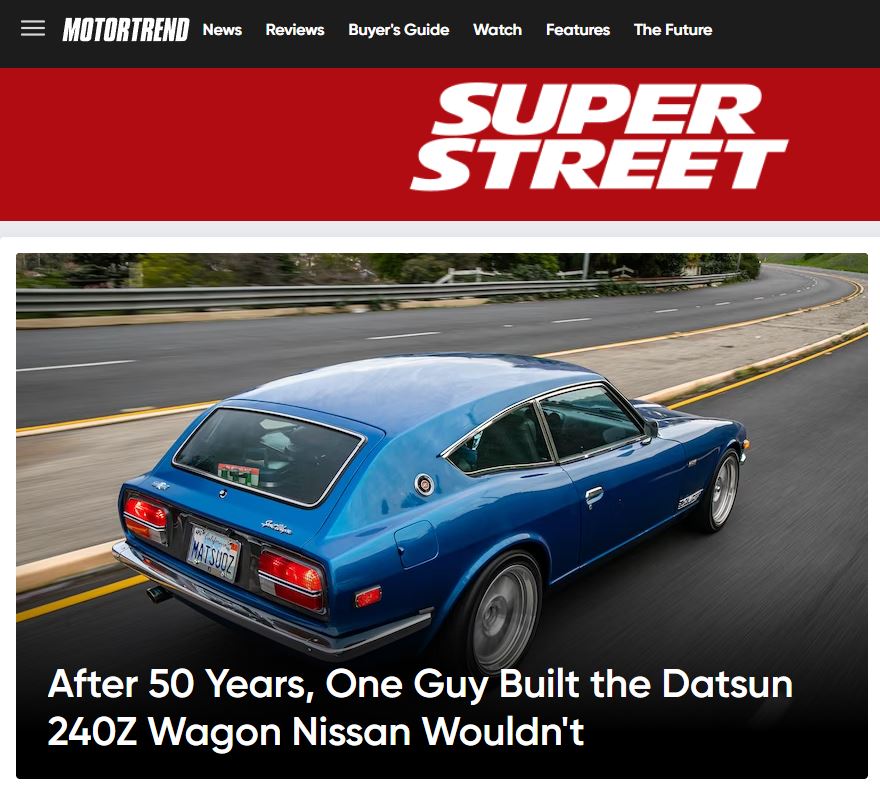Direct quote from SS:
The Z car's designer proposed a Sport Wagon, but Nissan only signed off on the coupe. Jay Ataka aimed to change that.
Rodrez Writer Recinos Photographer
Feb 14, 2023
For over five decades automotive enthusiasts have been entirely enamored with Datsun Z-cars, from the original 240Z through the later 260Z and 280Z—and then on to the ZX models and eventually the modern Zs. The long-running, affordable sports car carries a legion of fans for each of its seven generations and restored and modified versions of its original S30 chassis are more popular now than ever. Even if you're not all that familiar with the early Z, this Datsun 240Z
Legendary Visionary
Sport Wagon's silhouette tells you that it's unlike any other.
Over half a century ago, the head honchos at Datsun/Nissan put quite a bit of weight on the shoulders of a young designer named Yoshihiko Matsuo. He was assigned a project that would eventually birth the original Fairlady Z—the brand's most coveted nameplate. Interestingly enough, Matsuo not only visualized and penned the sexy Z-car coupe lines that we all know and love, but he also envisioned a targa-top, convertible, notchback, and GT race car version of the Z as well as a Sport Wagon, or "shooting brake" design.
Ultimately, Nissan's executives agreed on the coupe, and it would go on to debut and become a smash hit for the Japanese automaker. That unique long-roof design would never go on to materialize and might've been forgotten by most, but not Jay Ataka, a Z-car enthusiast and award-winning builder. In 2012, Matsuo attended ZCon in Arizona, and Ataka shuttled the legendary designer to Los Angeles shortly after. Along the way, he asked whatever happened to that shooting brake Z, and after discussing it during the long drive, he asked for permission to build one of his own.
Having received the designer's blessing, the ball was in Ataka's court, but things wouldn't get underway immediately. In fact, over a year went by and Matsuo came back to the U.S. for another ZCon visit only to find that a chassis to build upon had yet to be sourced. Taking note of his disappointment, Ataka began tinkering with a model that he could literally mold into the Sport Wagon idea that he'd been thinking about. That seemingly lit the fire and he picked up a '78 280Z 2+2 chassis and outfitted it with a hodgepodge of wood and cardboard to try and emulate the shape he was after while referring back to those original design sketches from the '60s.
The Blueprint
With over 20 attempts and admittedly very little success, Ataka reached out to Matsuo for some much-needed input. With the help of a liaison, the team emailed back and forth with brainstorm sessions and eventually that cardboard was traded for thin metal, and a second 2+2 chassis was purchased strictly for its roof and rear hatch, but that wasn't enough. Eventually, a third 2+2 280Z was brought into the mix, this one lacking an engine and drivetrain, and all three would offer pieces to the experimental build. Expected rust and body repairs were to be handed off but with everyone booked for months, Ataka decided to take on the body work himself.
In order to get the 240Z aesthetic he was after, Ataka painstakingly removed the 280Z's 5-mph bumpers and backdated the look. Outfitted with a makeshift blueprint of the newly formed rear, the car was handed over to a fabricator to handcraft the required additions. The days ticked away as the custom pieces were fitted and adjusted over and over before everything was welded to the body. Satisfied with the car's new shape, it was sprayed in a similar blue to Matsuo's original design. Reassembly would commence shortly after and Ataka tells us that Hiro Hatanaka of Datsun Freeway, Japan, supported the entire build journey and played a large part in supplying key parts as well as assisting in communication with Matsuo. Hatanaka even sent his chief technician, Mr. Iwai, to Los Angeles to give Ataka a hand during the build's final stage.
Along the upper portion of the front fenders, you'll spot Ataka's signature immortalized on a custom placard created by Ataka in tribute and below, chrome grills emblazoned with "Sport Wagon" add a touch of '70s flair. Originally, the Z was fitted with a set of period-correct, genuine Nissan alloy wheels, but in 2018 he decided to add a larger wheel and tire package and opted for 17x8 front/10 rear Rotiform wheels with Advan Neova AD08R tires to give it a modern look.
Step around to the side and the custom rear roofline slopes slightly before waterfalling into a custom hatch window and terminating with a short decklid, while the car's three-piece taillight bezel was extended and formed into a single piece. The one-off hatch and rear side windows exaggerate the roof's curvature and feature a slick lower bend that perfectly matches the Z's hips. Rather than appearing to be a completely custom affair, the Z Sport Wagon's exterior looks like a true Nissan prototype that slipped through the cracks and was finally released after a multi-decade hibernation.
No Corners Cut
Ataka's talents didn't end with the outside appearance as he turned his skills and attention toward revamping the interior. Fresh materials, as many new pieces as possible, and some time-consuming restoration brought the car's cabin makeover up to "better than new" status. Matsuo's signature can once again be found on the glovebox and a Sport Wagon badge was placed just above, on the immaculate dashboard.
Wood surfaces in the center console surround an automatic gear selector that might seem blasphemous to some Z-enthusiasts but in light of Matsuo's vision of offering multiple Z-cars for multiple purposes, it seems fitting that the wagon would shift automatically. You'll find more period-correct surfaces in the rear, where Ataka came up with his own luggage railings that combine finished wood and polished metal in-between fresh black carpeting. The rest of the interior panels are a result of his hard work, and the detail-obsessed builder notes that he spent six hours carving a piece of mahogany to create the finishing touch on the gear selector.
During the build process, Ataka maintained communication with Matsuo, even visiting him at one point as the build was deep in progress. The two would team up in the U.S. in 2014 to unveil the auspicious project and display at events including ZCon, where fans got an up-close look at the one-of-one creation and had the opportunity to meet the legend that originally designed it, alongside the man who eagerly carried the torch and brought a dream to fruition.
This was the final project that Yoshihiko Matsuo would take part in, as he passed away in 2020 at the age of 87. His dream, however, lives on with Jay Ataka's incredible Phantom Z Sport Wagon.



